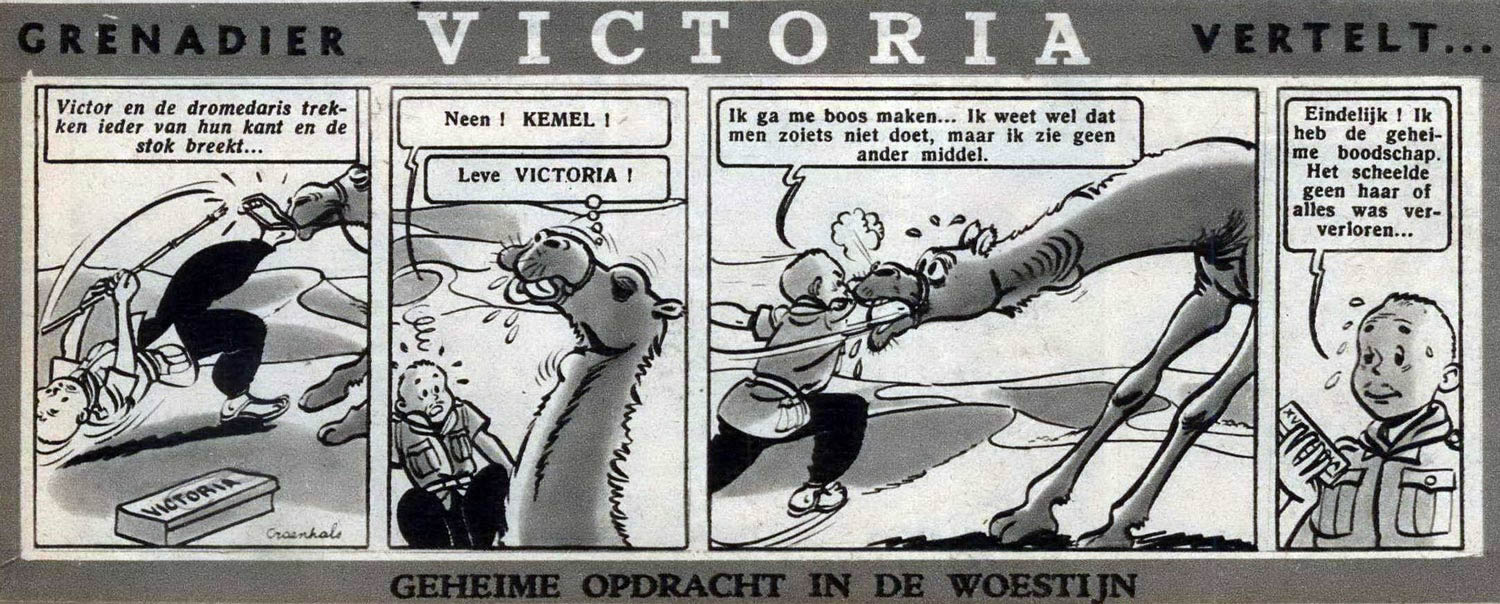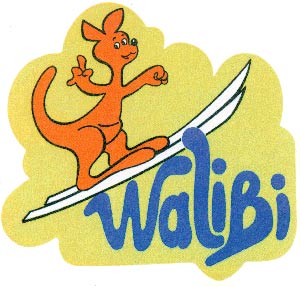Guy Dessicy in the Belgian Comic Strip Center. Picture © D. Pasamonik.
Guy Dessicy was a Belgian graphic artist, with a long association with the publishing house Lombard. As one of the early members of Studio Hergé in the 1940s and early 1950s, he was the colorist on several of Hergé's 'Tintin' stories. While his own career in comic production was short and fully in the service of Hergé, he did have a significant impact on the Belgian comic scene as the head of Publiart, Lombard's commercial agency specializing in comic book merchandising. He was also a co-founder of the Belgian Comic Strip Center in Brussels. His name is often misspelled as Guy Decissy.
Early life
Guy Dessicy was born in 1924 in Saint-Gilles/Sint-Gillis, one of the Brussels suburbs. His father was a mechanic and his mother a designer of clothing. Through a teacher with an interest in art, the twelve-year old Guy was introduced to the local art group Capelle-aux-Champs in Woluwe-Saint-Lambert. Its members were linked by a common association with scouting and Catholic circles, the same artistic ideals, and a desire to replace an overly rigid religion with a more mystical spirituality. There, Dessicy got acquainted with the novelists and poets Maurice Carême, Jean Libert and Geo Norge, the woodcut artist Bonaventure Fieullien and the graphic designer Evany. Through this group, he also met the comic creator Hergé, who already enjoyed national fame thanks to the success of his 'Tintin' comics. Guy Dessicy went on to study architecture and painting at the Academy of Brussels, but dropped out after two years.
Reworked edition of Hergé's 'Popol et Virginie Chez des Lapinos', colorized by Dessicy.
Studio Hergé
In 1947, Guy Dessicy joined Studio Hergé, initially as a replacement for Edgar P. Jacobs. However, despite some training by Jacques Van Melkebeke, Dessicy's artwork couldn't meet Hergé's high quality standards. Instead, he became the studio's colorist, starting with providing the colorization of Hergé's funny animal comic 'Popol et Virginie Chez des Lapinos', which had originally been published in 1934 in black-and-white. For the book reprint, Dessicy also redrew some backgrounds. During his time with the studio, he also colorized and remounted some of the 'Tintin' albums that were redrawn or reworked for their new book release. Since he lived nearby, Dessicy usually did his coloring work at Hergé's house.
However, Guy Dessicy had some significant impact on the 'Tintin' stories in other ways. He often made poses, so that Hergé and his assistant Bob De Moor had a model to base their sketches on. Interviewed by Toon Horsten for the book 'Kinderen van Kuifje' (Linkeroever Uitgevers, 2011), Dessicy recalled that he often had to play the characters of Thompson and Thomson and wear a bowler hat. He also claimed that he inspired the Tintin character Abdallah. Dessicy had read a short story by O. Henry, 'The Ransom of Red Chief' (1907), in which two gangsters kidnap a child that turns out to be such an obnoxious brat that they are more willing to get rid of him than to keep him hostage. After telling Hergé the basic outline of this story, most of the plot in 'Tintin in the Land of Black Gold' (1950) was shaped. Yet Dessicy always insisted that he merely gave Hergé a vague idea with which he still did his own thing. Apart from Hergé, Dessicy anonymously colorized comics by other artists too, including Willy Vandersteen's first 'Suske en Wiske' story for Tintin magazine, 'Het Spaanse Spook' (1948-1950).
Publiart advertisement for Victoria chocolate by François Craenhals (1955). Dutch-language version.
Publiart
By 1953, the production at Studio Hergé had slowed down, while on the other hand Bob De Moor had proven to be a very capable right-hand man for Hergé. Around this time, Hergé had hired extra colorists and most of the time, Guy Dessicy had nothing to do. Luckily, new opportunities arose, when Lombard publisher Raymond Leblanc hired Dessicy to design a Tintin store in the Rue du Lombard, and develop a shop-window dedicated to the Tintin coupons. Dessicy noticed that this type of commercial work suited him, and after a while, he was put in charge of Lombard's new in-house advertising agency Publiart, while also named head of Tintin magazine's publicity department. During his 35-year tenure with Publiart, Guy Dessicy received a considerable amount of creative freedom. Raymond Leblanc's only condition was that this freedom was translated into financial profits.
Under Dessicy's reign, Publiart specialized in advertisements that made use of comic strips and comic art, as well as merchandising based on Belgian comic characters. As the effort proved highly successful and profitable, it quickly urged Tintin's rival magazine Spirou to request Publiart's services as well. This allowed Publiart to broaden its scope and create advertisements around comic characters from the two best-selling Belgian comic magazines of the time.
Publiart advertisement for Ajax bicycles (1959). Artist unknown, maybe Tibet? Dutch-language version.
Publiart also proved a starting point for a new generation of comic artists. Among the many later-day icons who started, or boosted, their comic career at Dessicy's agency were Berck, François Craenhals, Raymond Macherot, Dany, Mittéï, Géri, Philippe Geluck, Jean Graton, Hermann, Tibet, William Vance, Carlos Roque and Albert Weinberg. Most of them were later rewarded with their own comic series in Tintin magazine, provided that they could combine this production with their advertising comic duties. Publiart made ads for many companies, including Parein cookies, Rombouts coffee, Côte d'Or chocolate, Salik jeans and the Walibi theme park in Waver, Belgium. By the 1960s, Publiart expanded its activities, and also took on the development of slogans and mascots. For instance, Dessicy thought up the classic advertising slogan "As-tu ton Tuc?" ("Do you have your Tuc yet?") for Parein's cookie brand Tuc. For Walibi, Dessicy designed their 1975 mascot, an orange wallaby. However, with the gradual decline of comic magazines in the 1970s, Publiart lost most of its relevance. In the early 1980s, Guy Dessicy resigned as head. In 1989, Publiart's final achievement was organizing a raffle at the opening of the Belgian Comic Strip Center in Brussels, not coincidentally a new project of Guy Dessicy.
Publiart advertisement for Hacosan by Géri (1959). Dutch-language version.
Belgian Comic Strip Center
Guy Dessicy had a passion for the late 19th-century, early 20th-century art movement Art Nouveau, particularly the work of Belgian architect Victor Horta. In 1979, Dessicy bought one of the houses Horta had designed in 1905, Maison Cauchie (Cauchie House) in Etterbeek, which was threatened with demolition. Around the same time, an exhibition of Hergé's work, 'The Imaginary Museum of Tintin', ran in the Palace of Fine Arts in Brussels. Hergé told his friend Dessicy that he would find it regrettable if all these exhibited memorabilia from his career would be locked away again. To keep these items on display, Dessicy suggested setting up a Tintin-themed museum in his recently purchased Maison Cauchie, a project that Hergé greenlighted. However, it was difficult to find investors and, as the years progressed, it seemed less likely that the museum would come about. A newspaper eventually reported about the problem and soon after, Dessicy was phoned by the architect Jean Breydel, who told him that he knew another Horta building in Brussels suitable for renovating into a museum: the Waucquez department store in the Rue des Sable/Zandstraat. Dessicy bought the building, but Hergé changed the original plan. Instead of a museum about him alone, he wanted it to become a museum for all Belgian comics.
Now devoted to a more general subject - Belgian comics - it became easier to rally sympathizers for the project. Hergé unfortunately never lived to see it, since he passed away in 1983. On 24 October 1984, a non-profit organization was founded, with as its chairman Bob De Moor, who was bilingual and knew basically everybody in the Belgian comic scene. The Belgian comics museum project was sponsored and promoted by the Flemish and Walloon comics organizations De Vlaamse Onafhankelijke Stripgilde and Upchic. Eddy Ryssack oversaw the proceedings on the Dutch-language side, while Dessicy took care of the French-language side. In April 1985, a delegation of comic authors met with King Baudouin/Boudewijn and Queen Fabiola at the Royal Palace to discuss their project and received the necessary funding. On 16 April 1986, a special benefit evening was organized. Most of the big names in the Belgian comic industry were invited, and even the reclusive Edgar P. Jacobs was present. Since parts of the building were still in a disastrous shape, a lot was camouflaged by hanging sheets over it. A special book, wine label and poster were handed out to visitors. After 24 April 1986, the project was finally able to continue, and the building was renovated by the architect Pierre Van Assche.
On 6 October 1989, the Belgian Comic Strip Center opened its doors in Brussels in the presence of the royal couple. Jean-Claude Salemi designed the poster for the opening day. Many examples of Publiart comics were part of the permanent exhibition. Scriptwriter Bob De Groot and Belvision's Michel Leloup were also involved in these early stages. Leloup later succeeded Guy Dessicy as the museum's director.
Publiart comic strip for Whip lemonade by Mittéï (1962).
Final years and death
In 2015, Dessicy made headlines again when he donated the correspondence between Hergé and his secretary Marcel Dehaye to the King Baudouin Foundation. He passed away on 29 July 2016 at Watermaal-Bosvoorde (Watermael-Boitsfort). He has a cameo in Bob de Moor's final 'Barelli' album 'Barelli in Bruisend Brussel/'Bruxelles Bouillonne' (1989).
Original Walibi logo design by Guy Dessicy.









